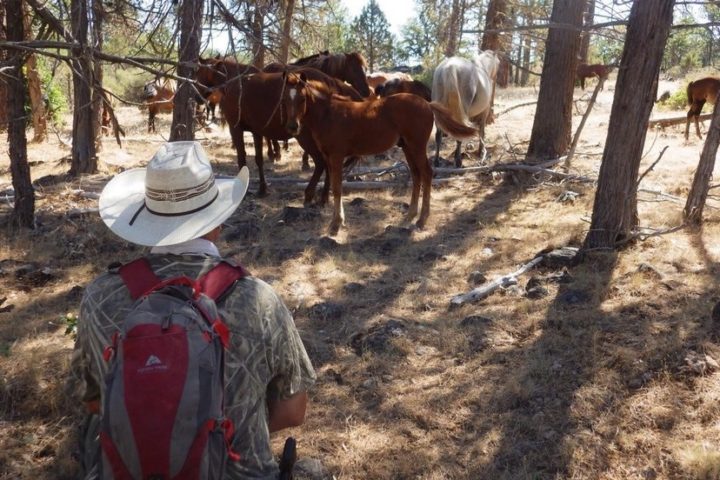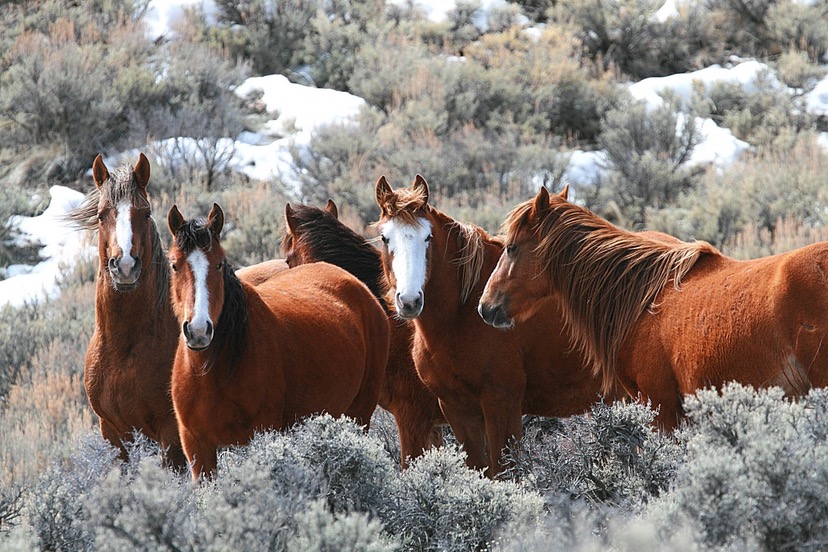The first and arguably most important step in solving any problem, even one as complex as the issues around the sustainable conservation of free-roaming American wild horses, is to:
1. Recognize there is a problem; and,
2. Identify and define the problem… at its root.
This is much harder to accomplish than it sounds. That’s because of the extensive white-noise that is primarily made-up from misinformation that largely fills the bandwidth of most interested wild horse stakeholders and informs the opinions of many others, including people who have ‘good intentions’.
Importantly, ‘good intentions’ can kill when they are combined with flawed applications of science. One example of this would be the improper application of cardio pulmonary resuscitation (‘CPR’) on a patient. Even with the ‘best intentions’ by a good Samaritan, the improper application of CPR will reduce the odds of survival of the patient.
The Problem
Wild horses in America are not being managed in harmony with natural evolutionary processes. All wildlife management must be conducted in concert with natural processes. Wild horses are desperate for a genuine solution from the pressures placed on public land grazing uses by consumerism, which land-use pressures are only going to grow.
The current ignorant yet trendy paradigm of trying to replace natural evolutionary processes that maintain wild horse (wildlife) populations in equilibrium with artificial man-made processes, as so-called ‘population management’, does not yield a sustainable natural population of genetically vibrant wild horses over the long-haul.

Today, there are too many non-profit activist organizations whose ignorance of natural evolutionary sciences is harming the long-term odds for a sustainable natural population of wild horses in America. These non-profits are harming the long-term genetic vigor of wild horses via their support, promotion or use of porcine zona pellucida (‘PZP’) and GonaCon on wild horses.
The ‘Wild Free-Roaming Horses and Burros Act’ (Public Law 92-195) was enacted by Congress in 1971 and signed by then President Richard Nixon to provide for the necessary management, protection and control of wild horses and burros on public lands by the Bureau of Land Management (‘BLM’) and the U.S. Forest Service (‘USFS’).
Currently, the BLM and USFS are ‘managing’ wild horses and burros in areas defined under the Act as Herd Management Areas (‘HMAs’), which today, 50-years after the Act was passed, are grazing areas where wild horses are now commingled with livestock.
Most HMAs (not all) have been made largely devoid of apex predators over the past 300-years of livestock management on these public lands. The practice of eliminating apex predators is deemed necessary by the livestock industry in order to meet the market demands of consumers for livestock-based products.
Consumerism drives the markets for livestock products, not the other way around.
The BLM and the USFS are caught in the politics related to the lobbying crossfire of both wild horse advocates, who want less cattle on public lands, and livestock grazers, who based-on meeting cost-effective market demands, argue they need more public lands grazing.
Currently, the makeshift solution to this difficult market-driven dilemma is being addressed with aggressive round-ups of wild horses to create more livestock grazing, combined with the uses of the chemicals PZP and GonaCon as supposed ‘contraception’ to stop wild horse population growth, which in light of the best science is a highly flawed management tactic and contrary to maintaining vibrantly sustainable wild horse genetics and populations.
The BLM and wild horse non-profit organizations and activists who are engaged in the selective breeding of native species American wild horses using PZP are meddling with natural processes that are critical for the long-term survival of American wild horses.
When a human decides which animals get to breed and/or which do not, that is by definition ‘selective breeding’. And that is contrary to the intent of the Wild Free-Roaming Horses and Burros Act (WFRHBA).
Pursuing wild horses with high-powered firearms and shooting them with projectiles filled with PZP is ‘harassment’ of wild horses and is arguably a violation of the intent and codification of the Act established by Congress to protect wild horses and burros.
Selective breeding of native wild horses by humans disintermediates the evolutionary process of ‘Natural Selection’ by the co-evolved predators of wild horses, which is critical to the continued survival and genetic vigor of wild horses.
‘Natural Selection’ is an essential evolutionary process in any co-evolved predator-prey relationship. This is why it is flawed management to maintain wild horse populations that are commingled with livestock populations in Herd Areas that have been made devoid of apex predators. This is great for livestock production, but terrible for wild horses, which require and depend upon their co-evolved predators for their genetic vigor and population equilibrium within any ecosystem.
Regardless of ‘good intentions’ by some wild horse non-profit organizations and activists, doing the wrong things for wild horses is harmful and inexcusable.
Keeping American wild horses commingled with livestock in herd areas where apex predators have been depleted is perpetrating an ecologic injustice upon native species American wild horses, and perpetuates an illogical range-war.
In the light of natural evolutionary processes that provide equilibrium among animal populations, current management tactics are obtuse as are the many very costly workarounds, such as the failed attempts to address the fallout (overpopulation) from a lack of natural wild horse predators, using expensive roundups and contraception.
A Modern Science-Based Solution
In a nutshell: relocating wild horses from areas of contention as intact family bands, as well as re-wilding wild horses from expensive off-range holding areas and into the remote wilderness, beyond conflict with livestock enterprises is the essence of the Plan.
America has more than 110-million acres of remote wilderness areas in the western states. Much of this wilderness is manifestly unfit for any livestock production due to difficult mountainous terrain, which adversely affects livestock management logistical costs, combined with the presence of robust populations of apex predators.
These economic challenges significantly increase costs of livestock production, thereby increasing the cost of goods sold (COGS) to a point where the end products are not competitively priced. Therefore, along with other laws, economics rules out any potential livestock grazing in such wilderness areas.
These same remote wilderness areas are nevertheless blessed with abundant water and forage, yet are suffering from almost annual catastrophic wildfire due to the depleted populations of large-bodied native herbivores (deer and elk) that had previously inhabited those landscapes. In the not-too-distant past, these same wilderness areas had proper population densities of deer, elk and wild horses, which through their grazing, maintained ground fuels (grass and brush) to nominal levels year-round, keeping wildfires in the realm of normal wildfire (less fuel means less heat).
There have been serious declines in deer and elk populations in some western states: California, Oregon, Washington, etc. And over the past decades, that has resulted in millions of tons of prodigious annually occurring ground fuels (grass and brush), which is now left ungrazed in these very remote wilderness areas. These ground fuels are then subjected to a warming climate, rendering these fuels viable for wildfire sooner in the season, and remaining as dry tinder longer.
Cattle and sheep have complex stomachs which digest virtually all the plant and grass seeds they consume, making them unable to germinate. Wild horses, on the other hand, pass virtually all the seeds they consume intact out onto the ground in their droppings and able to germinate, providing a critically important reseeding function for native plants.
The droppings of wild horses contain microorganisms (aka: microbiome) that help fire-damaged landscapes with pasteurized soils to recover via reestablishing the microbiome along with humus and the seeds of native flora .
Each wild horse deployed into these selected wilderness areas will symbiotically consume about 5.5 tons of grass and brush annually as the concurrently reseed the landscape, keeping a delicate ecological balance in place. The resulting wildfire fuels reduction via wild horses is virtually cost-free for taxpayers, and simultaneously solves the livestock-wild horse conflict on lands (HMAs) where livestock production is virtually a permanent enterprise.
An added benefit is taxpayers no longer have to foot the bill for the $100 million-plus in annual costs that the BLM spends on rounding-up and warehousing wild horses off-range, nor the expensive taxpayer costs related to flawed contraception concepts that some people are motivated to support.
Two Potential Options Available To Allow Rewilding as well as Relocating Wild Horses:
1. Amending Section 1339 of the ‘Wild Free-Roaming Horses and Burros Act’ (Public Law 92-195) to allow the BLM and USFS to relocate and rewild wild horses into wilderness areas that are economically and ecologically appropriate.
Here is the current language that must be addressed:
§ 1339. Limitation of Authority:
“Nothing in this Act shall be construed to authorize the Secretary to relocate wild free-roaming horses or burros to areas of the public lands where they do not presently exist.”
Proposed amended language (by William E. Simpson II), for § 1339. Limitation of Authority:
“Nothing in this Act shall be construed to authorize the Secretary to relocate wild free-roaming horses or burros to areas of the public lands where they do not presently exist, with the exception that; in Wilderness Areas managed by the United States Forest Service (USFS) and/or the Bureau of Land Management (BLM) containing forests and/or other natural resources at risk of catastrophic wildfire; the BLM and the USFS shall under this Act have authority to re-wild American wild horses and burros from off-range holding facilities and/or relocate wild horses and burros from existing Herd Management Areas into such Wilderness Areas where it is ecologically and economically appropriate.”
2. Using existing law: Consolidated Appropriations Act, 2017 (HUMANE TRANSFER OF EXCESS ANIMALS SEC. 116) to transfer excess wild horses and burros currently in holding to other federal, state, and local government agencies for use as work animals.
H. R. 133—Page 358-359
HUMANE TRANSFER AND TREATMENT OF ANIMALS
SEC. 419.
(a) Notwithstanding any other provision of law, the Secretary of the Interior, with respect to land administered by the Bureau of Land Management, or the Secretary of Agriculture, with respect to land administered by the Forest Service (referred to in this section as the “Secretary concerned”), may transfer excess wild horses and burros that have been removed from land administered by the Secretary concerned to other Federal, State, and local government agencies for use as work animals.
(b) The Secretary concerned may make a transfer under sub-section (a) immediately on the request of a Federal, State, or local government agency.
(c) An excess wild horse or burro transferred under subsection (a) shall lose status as a wild free-roaming horse or burro (as defined in section 2 of Public Law 92–195 (commonly known as the ‘Wild Free-Roaming Horses and Burros Act’) (16 U.S.C. 1332)).
(d) A Federal, State, or local government agency receiving an excess wild horse or burro pursuant to subsection (a) shall not (1) destroy the horse or burro in a manner that results in the destruction of the horse or burro into a commercial product; (2) sell or otherwise transfer the horse or burro in a manner that results in the destruction of the horse or burro for processing into a commercial product; or (3) euthanize the horse or burro, except on the recommendation of a licensed veterinarian in a case of severe injury, illness, or advanced age.
(e) Amounts appropriated by this Act shall not be available for (1) the destruction of any healthy, unadopted, and wild horse or burro under the jurisdiction of the Secretary concerned (including a contractor); or (2) the sale of a wild horse or burro that results in the destruction of the wild horse or burro for processing into a commercial product.
You can find more information and a draft outline for a legislative bill at: https://www.WildHorseFireBrigade.com
William E. Simpson II is a naturalist, author, and conservationist living in the Soda Mountain wilderness area among the wild horses that he studies. Learn more at Wild Horse Fire Brigade.


